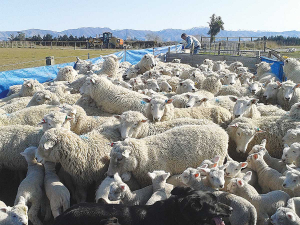Managing triplet-bearing ewes
The targeted management of triplet-bearing ewes in the four to six weeks before lambing can significantly increase the kilograms of lamb weaned and therefore dollars produced per ewe.
 Heavier ewes in good condition invariably have better lambing performances than lighter, skinnier ewes.
Heavier ewes in good condition invariably have better lambing performances than lighter, skinnier ewes.
Ewes that gain condition before and after mating have higher lambing percentages than ewes that simply stand still.
Most farmers are aware of this and try to manage their flocks accordingly. The challenge they face is working out what the condition of the flock is. The best way to do this is by condition scoring.
When a sheep is newly-shorn most farmers can easily tell if it is skinny or fat. But it is very difficult to judge the fatness or condition of woolly sheep by eye. Even the use of scales can be misleading, with small fat ewes the same weight as large-framed skinny ewes.
Condition scoring by hands overcomes these problems and is also quicker than weighting. A very simple scale of 0 to 5, increasing with level of fatness, from extremely emaciated (0) to overfat (5) is generally used.
Condition scoring assesses the amount of body fat or condition by feeling the vertical (spine) and horizontal (lumbar) processes along the loin area. The technique measures condition regardless of body weight (for example, at 55kg liveweight, a small-framed ewe may have a condition score of 4, and a large-framed ewe a condition score of 2).
As a rule, there is about 5kg difference in liveweight between condition scores for a given sheep.
Score 1: Very poor condition
The vertical and horizontal processes are prominent and sharp. The fingers can be pushed easily below the horizontals and each process can be felt. The loin muscle is thin with no fat cover.
Score 2: Store condition
The vertical processes are prominent but smooth, individual processes being felt only as corrugations. The horizontal processes are smooth and rounded, but it is still possible to press the fingers under them. The loin muscle is of moderate depth but with little fat cover.
Score 3: Forward store condition
The vertical processes are smooth and rounded; the bone is only felt with pressure. The horizontal processes are also smooth and well covered; hard pressure with the fingers is needed to find the ends. The loin muscle is full, with moderate fat cover.
Score 4: Fat
The vertical processes are only detectable as a line; the ends of the horizontal processes cannot be felt. The loin muscles are full and have a thick covering of fat.
Score 5: Over-fat
The vertical processes cannot be detected even with pressure; there is a dimple in the fat layers where the processes should be. The horizontal processes cannot be detected. The loin muscles are very full and covered with very thick fat.
The higher ovulation rates and lambing percentages associated with ewes that have been well-fed before and during mating.
These are influenced by liveweight and whether or not the ewe has been gaining condition (flushing) during this period. Heavier ewes in good condition invariably have better lambing performances than lighter skinnier ewes. Scientists estimate lambing percentages increase by 6-10% for every extra unit of body contition score at tupping.
The flushing effect may provide an additional 5-10%.
To maximise lambing percentages, ewes should not lose condition during mating and should ideally have a condition score of 3 or 4. They should be the high priority mob, but on many farms they will be competing for the best paddocks with lambs that remain to be finished.
If so, it will pay to consider whether this is the best use of feed - your lamb growing and marketing policy may need adjusting.
Trade Minister Todd McClay says New Zealand has no intention of backing down in a trade dispute with Canada over dairy products.
There have been leadership changes at the Hamilton-based Dairy Goat Co-operative, which has been struggling financially in recent years.
Horticulture NZ chief executive Nadine Tunley will step down in August.
OPINION: In recent years farmers have been crying foul of unworkable and expensive regulations.
Another 16 commercial beef farmers have been selected to take part in the Informing New Zealand Beef (INZB) programme designed to help drive the uptake of genetics in the industry.
Trade Minister Todd McClay says Kiwi exporters will be $100 million better off today as the NZ-EU Free Trade Agreement (FTA) comes into force.

OPINION: The new government has clearly signalled big cuts across the public service.
OPINION: Your canine crusader is not surprised by the recent news that New Zealand plant-based ‘fake meat’ business is in…